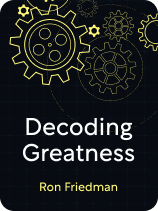

This article is an excerpt from the Shortform book guide to "Decoding Greatness" by Ron Friedman. Shortform has the world's best summaries and analyses of books you should be reading.
Like this article? Sign up for a free trial here.
Do you want to make something memorable? What if you could recreate what you admire? What’s the surest road to success?
In Decoding Greatness: How the Best in the World Reverse Engineer Success, Ron Friedman provides a step-by-step process to help you succeed. The key is to find work you admire, take it apart to see how it’s made, and then create your own version of it.
Keep reading for an overview of this book that will inspire you, whether you’re an artist looking to hone your craft or an entrepreneur hunting for the next big business idea.
Overview of Decoding Greatness
What’s the secret to elite performance and creative innovation? According to performance expert Ron Friedman, it’s not about being talented or working hard—it’s about strategically learning from the greats in your field through the process of reverse engineering. By doing so, he says, you’ll spark original ideas, improve your skills, and ultimately find creative success. This is the premise of his book, Decoding Greatness: How the Best in the World Reverse Engineer Success.
Friedman is a psychologist, consultant, speaker, and author who specializes in the psychology of workplace performance. His first book, The Best Place to Work, explores how leaders can boost innovation, productivity, and worker happiness. In Decoding Greatness, Friedman analyzes top performers ranging from Steve Jobs to Agatha Christie to Roger Federer to show how readers can borrow the same techniques that these icons used to achieve greatness. Friedman argues that whether your goal is to get a show at an art gallery, win a marathon, or nail a big product pitch, his techniques can help you improve your performance and do great, memorable work.
Our overview is organized into three parts:
- In part one, we’ll explore reverse engineering in depth. We’ll show you how to take apart and learn from great works in your field and how to turn what you learn into new creative ideas.
- In part two, we’ll explain how to improve your skills so that you can successfully execute your new creative vision.
- In part three, we’ll show you how to fine-tune your work by soliciting useful feedback and working one-on-one with experts.
(Shortform note: Although Friedman presents reverse engineering as the book’s central focus, only a little more than a third of the book focuses specifically on this topic. Friedman’s main claim is that reverse engineering is a way to generate creative ideas. The rest of the book discusses the techniques needed to execute and perfect these ideas—and these techniques are more about practice and soliciting feedback than about reverse engineering per se. As the book itself does, we present reverse engineering as a way to generate ideas, and then we introduce separate techniques you can use to carry out those ideas.)
Part 1: Steal From the Greats
Friedman argues that doing great work isn’t just about being talented or working hard—it’s about learning from the greats in your field by reverse engineering their creations. Reverse engineering is the process of analyzing and reproducing existing work in order to enhance your skills and expand your creativity. Friedman explains that, while reverse engineering might feel derivative (since you’re borrowing from others), in the long term it actually makes you more creative because it builds your mental library of successful creative “recipes” and techniques.
In this section, we’ll explain how to reverse engineer works that you love. Then, we’ll share Friedman’s strategies for moving from copying and reproducing existing works to making creative contributions of your own.
How to Reverse Engineer
Friedman explains that reverse engineering is a matter of finding the underlying structures and formulas in your favorite works. To find these structures, he says, you should collect examples of work that you love and analyze it to learn how it was made. Friedman offers a variety of techniques you can use to analyze work that you admire.
Copy
The simplest way to absorb the principles of great work is simply to copy it as closely as you can. By doing so, you’ll start to notice the decisions that more experienced practitioners made, which gives you a wider palette to draw from in your own work.
Find a Template
Another technique is to find the templates underlying your favorite works. To do so, Friedman suggests making a reverse outline of a work you like in order to reveal the larger structure behind it. By doing so, you’ll discover templates that you can follow when creating your own work.
Break It Into Metrics
Instead of using a reverse outline to reveal the generic structure underlying your favorite works, you can also break a work down into a set of metrics that give you a statistical (rather than structural) target to aim for in your own creations.
Turn Copying Into Creativity
Friedman notes that most people resist the idea of copying or even taking influence from existing work, fearing that doing so will limit creativity. However, he argues that thoughtful reverse engineering actually enhances your creativity. That’s because, according to Friedman, successful creative ideas balance formula with novelty. If an idea is too familiar, it’ll feel boring and derivative. But if it’s too creative—if there’s nothing your audience can immediately grasp—it might be rejected for seeming crazy or unrelatable.
The good news, Friedman says, is that, when you’re trying to be creative, your job isn’t to come up with something wholly unique—it’s to take existing ideas and formulas and vary them until they feel fresh. He presents several approaches to doing so.
Combine Unrelated Ideas
One way to come up with a new idea is to combine two or more unrelated existing ideas.
Seek New Perspectives
In addition to combining disparate influences to create a new idea, you can also spark creativity by bringing together people with different perspectives, backgrounds, and abilities. For instance, when Apple was designing the graphic interface for the original Macintosh, the company hired Susan Kare—whose background wasn’t in technology but in fine arts—to create the computer’s typefaces and icons.
Bring a Background Element Forward
In addition to combining different ideas, Friedman says that you can also find and emphasize a less-noticed or underappreciated element of an existing idea.
Embrace Imperfect Copies
Another way copying can lead to creativity, Friedman says, is that sometimes your attempts to copy or combine ideas fail in ways that lead you to new insights. In these cases, Friedman suggests that you embrace your imperfections and build them into something new.
Part 2: How to Get Good at What You Do
While reverse engineering can help you clear the initial hurdle of creativity—generating ideas—your next challenge will be building your skills enough to execute those ideas to their full potential. In this section, we’ll explore Friedman’s strategies for improving your implementation, including how to practice effectively, improve your performance by measuring it, and mitigate the risks you have to take to learn and grow.
Practice Effectively
If you want to get better at something, it makes sense that you’d need to practice. But Friedman argues that it’s easy to practice incorrectly or inefficiently—so to avoid wasting your time and effort, he offers several guidelines for effective practice.
Reflect on Your Practice
Friedman argues that the most important aspect of effective practice is self-reflection. Keep track of your goals, the practice routines and performance strategies you employ to reach those goals, and your actual performance. Regularly review each of these elements with an active, critical eye to determine which strategies or approaches worked well and which didn’t.
Friedman suggests that journaling is an especially good way to reflect on your practice. He specifically recommends five-year journals, which allow you to make entries for the same date for five consecutive years so that you can review where you were at specific points in the past. In the process, you have a chance to notice relevant patterns that might not be obvious on a day-to-day level.
Challenge Yourself
Friedman also argues that for practice to be effective, it needs to be challenging—it should push you past your current comfortable skill level. If practice is too easy or too repetitive, you stop paying attention to what you’re doing, which halts growth and can harm your performance.
Similarly, Friedman stresses the importance of mixing up your practice so that you don’t fall into routines. The problem, he says, is that if your practice regimen is the same every time, you get bored: Your brain checks out and you stop learning. To avoid this problem, find new ways to develop the same skills, or add new obstacles and challenges to keep things fresh.
Imagine Your Performance Ahead of Time
In addition to physical practice, Friedman recommends that you mentally rehearse prior to your actual performance. To do so, he suggests imagining your performance as specifically as you can, including the time and place, the sensory details you expect to encounter, and the nuances of the behaviors you’ll need to perform.
Friedman argues that this kind of imagery can improve your actual performance in several ways:
- It locks down important details.
- It prepares you for the stressors and challenges you’ll likely face.
- It helps you strategize because you’ll foresee potential problems and find ways to avoid or compensate for them.
Friedman cautions that when using this kind of imagery, it’s important to imagine your performance, not your success—in other words, imagine the specific behaviors you’ll perform in the kitchen, not how good the food will taste or how proud you’ll feel when serving your guests. He points to a study showing that visualizing success actually makes your performance worse. That’s because when you imagine yourself succeeding, you get an emotional payoff that tricks your brain into thinking you have already succeeded. This payoff lowers your motivation and makes you more complacent, which ultimately makes you less effective.
Improve Your Performance With Metrics
Another way Friedman says you can improve your performance is to set goals and then develop key metrics to help you track your progress toward your goals. He explains that doing so encourages you to think critically about your goals and how to achieve them.
That’s because metrics force you to break down your larger goal into component steps, behaviors, or milestones. In turn, these milestones help you track your progress and also detect areas where your performance is lagging, which Friedman says allows you to take a strategic approach to improvement.
Friedman warns that if you do use metrics, you should be careful not to get too focused on metrics for metrics’ sake. He explains that metrics are simplifications, and if you choose your metrics poorly, you might miss important aspects of your behavior or even let your pursuit of numbers distort your actual behaviors and thereby undermine your goals.
Mitigate Risk When Trying New Things
Getting good at anything requires risk. Creativity and effective practice both require you to stretch yourself, which means that sooner or later, you’re bound to fail. Friedman explains that this kind of failure is a good thing—it’s how you learn—but he also acknowledges that the possibility of failure can prevent necessary risk-taking if the stakes are too high, such as when a failure might damage your reputation or your financial position. The answer, Friedman says, is to lower the stakes of failure by strategically mitigating your creative risks using the following strategies.
Strategy #1: Find a Test Audience
A test audience lets you try out your new idea and get feedback from your intended audience while you’re still figuring things out and the stakes are low.
Strategy #2: Sell Before You Create
Friedman suggests finding a way to sell your product or service before you create it (such as by creating a prototype and taking a list of preorders). This technique helps you gauge how much demand there is before you invest your resources.
Strategy #3: Use an Alias
Friedman suggests working under a pseudonym, stage name, or sub-brand while trying out new ideas. Doing so allows you to experiment without damaging your established reputation, confusing your audience, or creating false expectations.
Strategy #4: Diversify Your Career
Friedman recommends keeping a day job as a steady source of income that allows you to take more risks outside of work. But he also recommends getting creative in how you leverage your talents to make money. The more you spread yourself around, Friedman explains, the more you diffuse the risk associated with any one venture.
Part 3: Making the Most of Feedback and Expert Guidance
As you work to grow your skills and expand your creative output, it’s crucial to get feedback and guidance from others, but it’s not always easy to do so. Friedman cautions that much of the time, feedback from others isn’t that helpful, and similarly, even if you’re lucky enough to consult with an expert in your field, you’ll find that many experts make poor teachers and coaches.
In this section, we’ll explain Friedman’s reasoning for why that’s the case and share his strategies for getting everything you can from feedback and expert opinions.
How to Get Useful Feedback
Friedman argues that most feedback is unhelpful because it’s too vague, often taking the form of “I liked it” or “I didn’t like it,” and it can easily swing between extremes of supportiveness or criticism. Instead, Friedman argues that good feedback needs to be specific and actionable.
To elicit helpful feedback, Friedman recommends that you point your reviewer to specific aspects of the work that you’re concerned about or deem critical. Similarly, Friedman recommends that you reframe critical feedback as steps for improvement.
How to Receive Feedback
Friedman points out that for feedback to be useful, you have to be receptive to it. That means not getting upset or defensive when you receive criticism. Friedman offers two strategies to help with this:
- Get some distance from your work.
- If you get critiques that hurt, take the time you need to process your emotions before you respond.
How to Learn From Experts
Finally, Friedman notes that if you’re lucky enough to get a chance to work directly with experts in your field, they might not be as helpful as you’d hope. He explains that experts often make poor teachers, trainers, and coaches. This is because they’ve so internalized their knowledge and skills that when they perform, they do so instinctively—which makes it hard for them to explain how they do what they do. Moreover, Friedman says, experts typically can’t remember (or imagine) what it’s like to be a beginner and lack the skills and knowledge they have now.
That said, if you have the chance to work with an expert, Friedman suggests that you make the most of their expertise by asking:
- How they got where they are: What practices and strategies did they find most (and least) helpful?
- How they do what they do: Have them spell it out, step by step.
- What they learned along the way: What do they wish they’d known when they started out?
As the conversation unfolds, Friedman says, don’t be afraid to ask them to elaborate on their answers or to ask for clarification if you don’t understand something they’ve said—experts don’t always realize when they’re using specialized language or breezing over complex ideas. If you’re confused, Friedman suggests that you ask for concrete examples or try repeating back complex ideas in your own words to check your understanding.

———End of Preview———
Like what you just read? Read the rest of the world's best book summary and analysis of Ron Friedman's "Decoding Greatness" at Shortform.
Here's what you'll find in our full Decoding Greatness summary:
- The secret shortcut to elite performance and creative innovation
- How to reverse engineer someone else's work to create your own
- How to lower the stakes of failure by mitigating your creative risks






